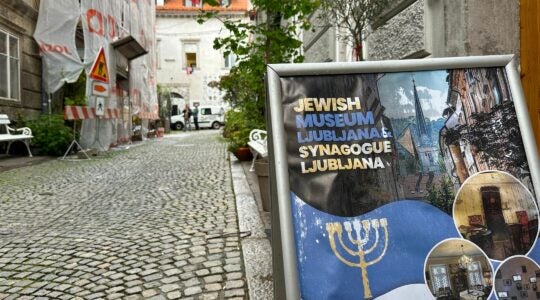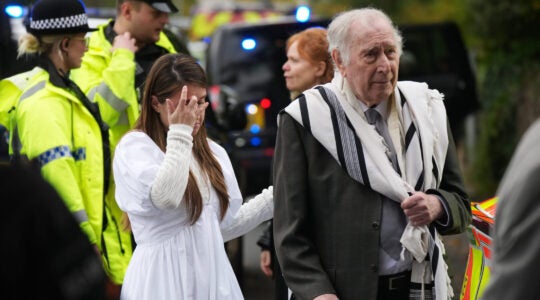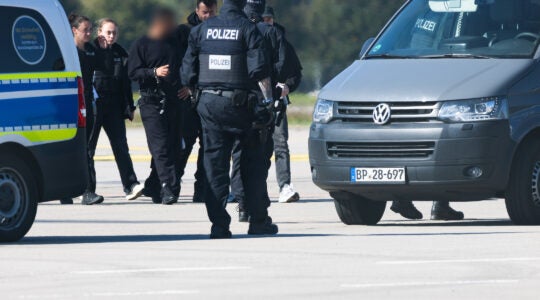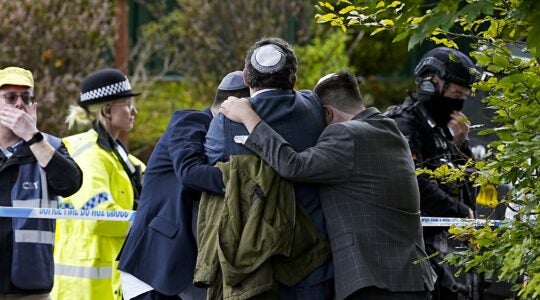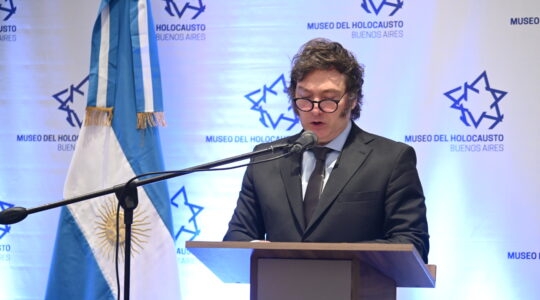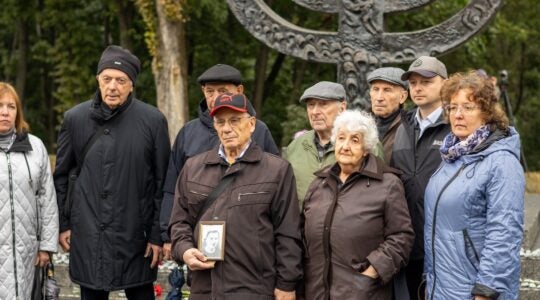
Lucia Leone opens the shutters of the little synagogue in San Nicandro. (Ruth Ellen Gruber)

Dancers outside the 13th century Scolanova synagogue in Trani, during the Lech Lecha Jewish culture festival, September 2012. (Ruth Ellen Gruber)

Ahead of Shabbat services in the 13th century Scolanova synagogue in Trani, during the Lech Lecha Jewish culture festival, September 2012. (Ruth Ellen Gruber)
SAN NICANDRO GARGANICO, Italy (JTA) – In the Christian cemetery of this sleepy farming town on the spur of Italy’s boot, Lucia Leone looks up at a row of tombs marked incongruously by Stars of David.
“That’s my mother,” she said. “And that’s my grandmother and great-grandmother. And that’s Donato Manduzio, who started everything.”
Manduzio, who died in 1948, was a self-taught local peasant, a disabled World War I veteran who in 1930 embraced Judaism on his own after having a visionary dream. A charismatic figure with a reputation as a faith healer, Manduzio attracted dozens of followers among his poverty-stricken neighbors.
The San Nicandro Jews observed their own brand of homemade Judaism for years, even during fascist rule and World War II. But eventually they were recognized by Italian Jewish authorities and, in a remarkable episode, they formally converted en masse in the 1940s.
“It would seem to be the only case of collective conversion to Judaism in modern times,” historian John Davis wrote in an acclaimed recent book about the case.
Manduzio died two months before Israel was born. But almost all the others in the group — about 70 people — made aliyah by 1949.
Leone, her family and a handful of other families are descendants of the four or five women who chose to stay behind. Some had never formally converted, some had non-Jewish husbands who didn’t want to leave. Against all odds, they kept Judaism alive in their homes — and in their hearts — for more than half a century, lighting the candles, keeping kosher, and observing Shabbat and the holidays on their own.
Until a decade ago, they maintained a low profile.
“We weren’t afraid, but as much as possible we kept our identity to ourselves,” Leone, who is in her late 40s, told JTA.
Today they form a fervent congregation of about 35 people that has won the embrace of Italy’s Orthodox Jewish mainstream community as part of a concerted new effort by the Union of Italian Jewish Communities, or UCEI, aimed at reaching out to so-called Returning Jews in the south.
“We don’t feel so alone anymore,” Leone said. “Every month a rabbi or teacher comes to us, and we meet up at the holidays and other times with Jews from Calabria, Sicily [see related story], Naples and elsewhere in Apulia. And of course there are a lot of websites and Facebook that help us keep in touch.”
Last year, seven San Nicandro Jews underwent formal, Orthodox conversions. Leone, her husband and their two grown children were among them.
“Finally!” Leone said. “Baruch Hashem! It took five years of study, but it was a beautiful experience.”
The San Nicandro Jews are a special case. But they are among dozens of other Italians in the southern part of the country who are embracing Jewish identity. Spread out around several towns and cities, most are descendants of anusim — Jews forced to convert to Christianity or face expulsion 500 years ago. Many describe mysterious family traditions rooted in Jewish practice: covering mirrors after a death or burning a bit of dough when baking bread.
“These are people who maintained their Jewishness for dozens of generations,” said Rabbi Scialom Bahbout, chief rabbi for Naples and Southern Italy. “They had very strong roots at the beginning, and these left their mark.”
Since 2010, Bahbout has been the UCEI’s religious reference point for the region.
“I’ve been trying to converge the people together from the various regions — Apulia, Calabria, Sicily — to create a movement,” he told JTA.
Others are reaching out, too. For the past decade, American Rabbi Barbara Aiello, whose own ancestors were anusim, has led Ner Tamid del Sud, an independent Jewish prayer and study center in Calabria. Aiello’s center operates outside the Orthodox Jewish establishment and is not recognized by the UCEI. But interest is so great, she said, that her group plans to open a new synagogue next summer when the building is completed.
“Ner Tamid del Sud is not affiliated with any Jewish movement,” said Aiello, who divides her time between Calabria and the United States. “We are pluralistic in that we are open and welcoming to Jews of all backgrounds, including interfaith families and Jewish families where the father is the Jewish parent.”
In early September, dozens of Jews from all over the south converged on Trani, an ancient port town on Italy’s heel, for a special Shabbat celebration that concluded Lech Lecha, a weeklong Jewish cultural festival held in Trani and nine other Apulian towns. No Jews live in Trani, but the town has been a focal point for Jewish revival since 2004, when a medieval synagogue there that for centuries had been used as a church was deconsecrated and restored as a house of Jewish worship.
This time, the congregation was too big for the tiny sanctuary, and Saturday morning services took place in the piazza outside. At sundown, Bahbout held aloft the havdalah candle as cries of “Shavua tov!” kicked off the festival’s final night.
Later, after dinner at a local restaurant that had been specially koshered for the occasion, Davide Scibilia, from Catania, Sicily, recounted how he had always known he was Jewish but only became affiliated with organized Jewry two or three years ago.
“Our Judaism was lived in the home,” he said. “We celebrated Shabbat, I didn’t go to school on Saturday, and my mother cooked dinner on Friday before sunset. My father circumcised me himself when I was eight days old.
“We didn’t eat meat because there wasn’t kosher food locally, so we cooked soya in all forms,” he added. “My mother was great in this.”
Back in San Nicandro, Leone showed a visitor the community’s one-room meeting hall, where a picture of Manduzio held pride of place, and the tiny nearby synagogue where they meet to pray and sometimes host gatherings of other Jews from the south. On most Shabbats there is no minyan; most community members are women.
Keeping the mitzvahs is not always easy, Leone said. For one thing, buying kosher meat means a four-hour drive to Rome. A proud Jewish mother, Leone kvelled over how her children were both immersed in Jewish life: Her daughter studies in Rome to be a Jewish teacher, and her son serves as a kosher supervisor, or mashgiach, at Shabbatons and other events.
She did confess to one concern, however: Her daughter is still single.
“Let’s hope for a good marriage — above all to a Jewish man,” she said. “She’s 27. It’s time.”
JTA has documented Jewish history in real-time for over a century. Keep our journalism strong by joining us in supporting independent, award-winning reporting.
